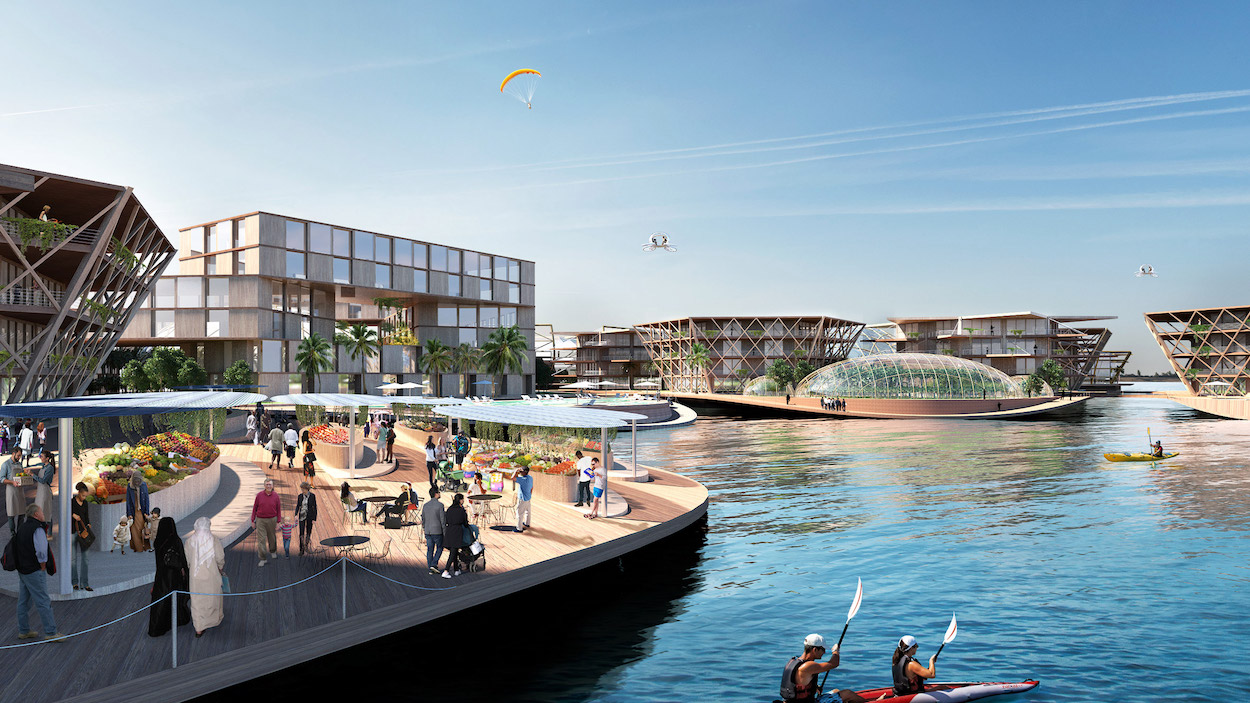Futurists have long dreamt up outlandish proposals for the utopian future of cities. Yona Friedman imagined Ville Spatiale, a development on stilts that layers over existing urban infrastructure and went on to inspire Moshe Sadie’s trailblazing Habitat 67; Archigram illustrated the modular, computer-controlled megastructures of Plug-in City; and Buckminster Fuller envisioned the Triton Floating City, an anchored community in Tokyo Bay connected to the mainland via bridges. Each proposal offered an optimistic peek into the metropolis of tomorrow.
The concept of the floating city is vogue again, only now the driving force is more dystopian than utopian. Global sea levels are rising at unprecedented rates, posing an imminent risk to the 40 percent of humanity that lives within 60 miles of a coast. One logical answer is to move inward, but that may cause mass displacement and the steep environmental toll that comes with land reclamation and deforestation, not to mention the exorbitant cost.
Some architects are toying with the idea of building self-sustaining cities that float in the ocean. One such project, designed by Bjarke Ingels Group (BIG) and currently being developed by the U.S. company Oceanix on the coast of Busan, South Korea, is billed as the “world’s first resilient and sustainable floating community.” The flashy renderings depict a ring of hexagonal-shaped islands that house 300 people and can be scaled ad infinitum into the sea to accommodate more people.
Oceanix City is the brainchild of Polynesian entrepreneur Marc Collins Chen, who came up with the idea while serving as French Polynesia’s minister of tourism in 2007. He and the self-proclaimed “seavangelist” Joe Quirk originally intended for the network of floating structures to serve as a tax-free enclave for the wealthy, but the approach was publicly reviled and likened to the Galactic Empire secretly building the Death Star. “I realized that the real future for these sorts of projects has to be closer to cities,” he tells The Guardian. “They have to be an extension of an existing city’s infrastructure.” Just a few years later, the journal Nature Conservation published the grim reality that rising oceans would likely submerge one third of French Polynesia’s 118 islands over the next six decades.
To overcome the Herculean engineering challenges, Collins Chen turned to Bjarke Ingels. BIG’s answer involves protecting the floating pods from ballast and wave forces, while incorporating technologies like Biorock, a self-repairing marine construction material that can also be used to create robust artificial coral reefs. “If this floating city flourishes,” Ingels said in a TED talk, “it can then grow like a culture in a Petri dish.” The project soon won the support of the UN-Habitat, the United Nations’ sustainable development arm. Naturally, the project has its detractors. Some continue to accuse Oceanix City of being a “vanity project for the rich” and express disbelief that it would make a dent in rapidly sinking cities like Jakarta, where five million people may need to eventually evacuate.
“Over the next 40 years, the world is expected to build 230 billion square meters [2.47 trillion square feet] in new construction—the equivalent of adding one New York City every month,” Collins Chen says. “This could be a way to accommodate that growth, without the devastating effects of land reclamation or deforestation.”
As far-fetched as the proposal sounds, floating cities have been a winning formula elsewhere in the world albeit on a small scale. The indigenous Uru people of Peru and Bolivia have long dwelled on self-made floating islands in Lake Titicaca, and work recently wrapped on Schoonschip, a small floating enclave in Amsterdam. The Maldives is also kicking off construction on a floating community of 5,000 low-rise homes later this year as the country expects to be uninhabitable by the end of the century.

